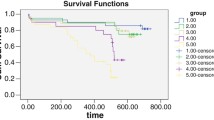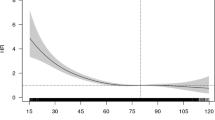Abstract
Background
The cardiovascular risk associated with an increase in serum creatinine below the acute kidney injury (AKI) threshold, during hospitalization, has not been studied in depth. We assessed patients’ features and outcomes associated with these changes.
Methods
Retrospective cohort study of 12,493 consecutive patients admitted to hospital throughout 12 months. We investigated the patients who had a small creatinine increase (SISCr) between 1.2 and <1.5 times the admission value, and tested the association of creatinine changes with the prevalence of cardiovascular disease (CVD). In a follow-up study, we assessed the all-cause mortality and its relationship with SISCr.
Results
Among patients with two or more creatinine measurements, 14.9% showed a SISCr. Older age, female gender and higher estimated glomerular filtration rate (eGFR) at admission were characteristics of these patients. The prevalence of CVD was 14.6% in patients with SISCr vs. 10.7% in those with stable creatinine (p < 0.001). SISCr was detected in 36, 26.6 and 18.9% of chronic heart failure (CHF), chronic ischemic heart disease (CIHD) and acute myocardial infarction (AMI) patients, respectively. The follow-up was 26.7 ± 10.6 months with 770 all-cause deaths. Serum creatinine increase above 20% was associated with a significant higher mortality compared to changes below 20%, adjusted hazard (HR) ratio 1.577 (p < 0.001). A higher risk was found associated with creatinine increases >1.5 times the baseline: HR 1.704 (p < 0.001).
Conclusions
In hospitalized patients, increases in serum creatinine below the AKI threshold are associated with CHF, CIHD and long-term mortality.

Similar content being viewed by others
References
Chertow GM, Burdick E, Honour M, BonventreJV, Bates DW (2005) Acute kidney injury, mortality, length of stay, and costs in hospitalized patients. J Am Soc Nephrol 16:3365–3370
Kidney Disease: Improving Global Outcomes (KDIGO) (2009) Acute Kidney Injury Work Group: KDIGO clinical practice guideline for acute kidney injury. Kidney Inter Suppl 2:1–138
Wang HE, Muntner P, Chertow GM, Warnock DG (2012) Acute kidney injury and mortality in hospitalized patients. Am J Nephrol 35:349–355
Newsome BB, Warnock DG, McClellan WM, Herzog CA, Kiefe CI, Eggers PW, Allison JJ (2008) Long-term risk of mortality and end-stage renal disease among the elderly after small increases in serum creatinine level during hospitalization for acute myocardial infarction. Arch Intern Med 168:609–616
Kao SS, Kim SW, Horwood CM, Hakendorf P, Li JY, Thompson CH (2015) Variability in inpatient serum creatinine: its impact upon short- and long-term mortality. QJM 108:781–787
Weisbord SD, Chen H, Stone RA, Kip KE, Fine MJ, Saul MI, Palevsky PM (2006) Associations of increases in serum creatinine with mortality and length of hospital stay after coronary angiography. Clin J Am Soc Nephrol 10:2871–2877
Tandon P, James MT, Abraldes J, Karvellas CJ, Ye F, Pannu N (2016) Relevance of new definitions to incidence and prognosis of acute kidney injury in hospitalized patients with cirrhosis: a retrospective population-based cohort study. PLoS One 11:e0160394
de Lusignan S, Tomson C, Harris K, van Vlymen J, Gallagher H (2011) Creatinine fluctuation has a greater effect than the formula to estimate glomerular filtration rate on the prevalence of chronic kidney disease. Nephron Clin Pract 117:c213–224
Carobene A, Ferrero C, Ceriotti F, Modenese A, Besozzi M, de Giorgi E, Franzin M, Franzini C, Kienle MG, Magni F (1997) Creatinine measurement proficiency testing: assignment of matrix-adjusted ID GC–MS target values. Clin Chem 43(1342):1347
Levey AS, Stevens LA, Schmid CH, Zhang YL, Castro AF 3rd, Feldman HI, Kusek JW, Eggers P, Van Lente F, Greene T, Coresh J, CKD-EPI (Chronic Kidney Disease Epidemiology Collaboration) (2009) A new equation to estimate glomerular filtration rate. Ann Intern Med 150:604–612
Lin J, Fernandez H, Shashaty MG, Negoianu D, Testani JM, Berns JS, Parikh CR, Wilson FP (2015) False-positive rate of AKI using consensus creatinine-based criteria. Clin J Am Soc Nephrol 10:1723–1731
Wang HE, Jain G, Glassock RJ, Warnock DG (2013) Comparison of absolute serum creatinine changes vs. kidney disease: improving global outcomes consensus definitions for characterizing stages of acute kidney injury. Nephrol Dial Transplant 28:1447–1454
Cruz DN (2013) Cardiorenal syndrome in critical care: the acute cardiorenal and renocardiac syndromes. Adv Chronic Kidney Dis 20:56–66
Shacham Y, Steinvil A, Arbel Y (2016) Acute kidney injury among ST elevation myocardial infarction patients treated by primary percutaneous coronary intervention: a multifactorial entity. J Nephrol 29:169–174
Krishnamoorthy A, Greiner MA, Sharma PP, DeVore AD, Johnson KW, Fonarow GC, Curtis LH, Hernandez AF (2014) Transient and persistent worsening renal function during hospitalization for acute heart failure. Am Heart J 168:891–900
Damman K, Valente MAE, Voors A, O’Connor CM, van Veldhuisen DJ, Hillege HL (2014) Renal impairment, worsening renal function, and outcome in patients with heart failure: an updated meta-analysis. Eur Heart J 35:455–469
Fülster S, Tacke M, Sandek A, Ebner N, Tschöpe C, Doehner W, Anker SD, von Haehling S (2013) Muscle wasting in patients with chronic heart failure: results from the studies investigating co-morbidities aggravating heart failure (SICA-HF). Eur Heart J 34:512–519
Amin AP, Spertus JA, Reid KJ, Lan X, Buchanan DM, Decker C, Masoudi FA (2010) The prognostic importance of worsening renal function during an acute myocardial infarction on long-term mortality. Am Heart J 160:1065–1071
Amin AP, Salisbury AC, McCullough PA, Gosch K, Spertus JA, Venkitachalam L, Stolker JM, Parikh CR, Masoudi FA, Jones PG, Kosiborod M (2012) Trends in the incidence of acute kidney injury in patients hospitalized with acute myocardial infarction. Arch Intern Med 172:246–253
Barrows IR, Raj DS (2016) Janus face of coronary artery disease and chronic kidney disease. J Am Heart Assoc 5:e003596. doi:10.1161/JAHA.116.003596
Tsai TT, Patel UD, Chang TI, Kennedy KF, Masoudi FA, Matheny ME, Kosiborod M, Amin AP, Weintraub WS, Curtis JP, Messenger JC, Rumsfeld JS, Spertus JA.(2014) Validated contemporary risk model of acute kidney injury in patients undergoing percutaneous coronary interventions: insights from the National Cardiovascular Data Registry Cath-PCI Registry. J Am Heart Assoc 3:e001380
Sabe MA, Claggett B, Burdmann EA, Desai AS, Ivanovich P, Kewalramani R, Lewis EF, McMurray JJ, Olson KA, Parfrey P, Solomon SD, Pfeffer MA (2016) Coronary artery disease is a predictor of progression to dialysis in patients with chronic kidney disease, type 2 diabetes, and anemia: an analysis of the trial to reduce cardiovascular events with Aranesp therapy (TREAT). J Am Heart Assoc 5:e002850. doi:10.1161/JAHA.115.002850.
Coca SG, Peixoto AJ, Garg AX, Krumholz HM, Parikh CR (2007) The prognostic importance of a small acute decrement in kidney function in hospitalized patients: a systematic review and meta-analysis. Am J Kidney Dis 50:712–720
Acknowledgements
We thank Cristina Losito for editing the manuscript.
Author information
Authors and Affiliations
Corresponding author
Ethics declarations
Conflict of interest
The authors declare that they have no conflict of interest.
Ethical approval
All procedures performed in studies involving human participants were in accordance with the ethical standards of the institutional and/or national research committee and with the 1964 Helsinki declaration and its later amendments or comparable ethical standards.
Informed consent
The present study is retrospective. For this type of study formal consent is not required.
Rights and permissions
About this article
Cite this article
Losito, A., Nunzi, E., Pittavini, L. et al. Cardiovascular morbidity and long term mortality associated with in hospital small increases of serum creatinine. J Nephrol 31, 71–77 (2018). https://doi.org/10.1007/s40620-017-0413-y
Received:
Accepted:
Published:
Issue Date:
DOI: https://doi.org/10.1007/s40620-017-0413-y




